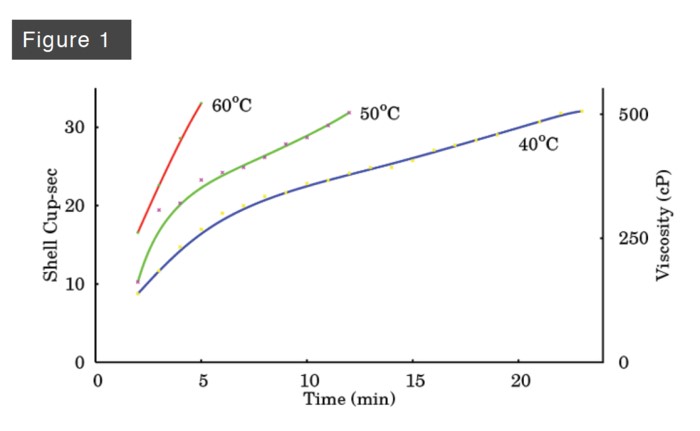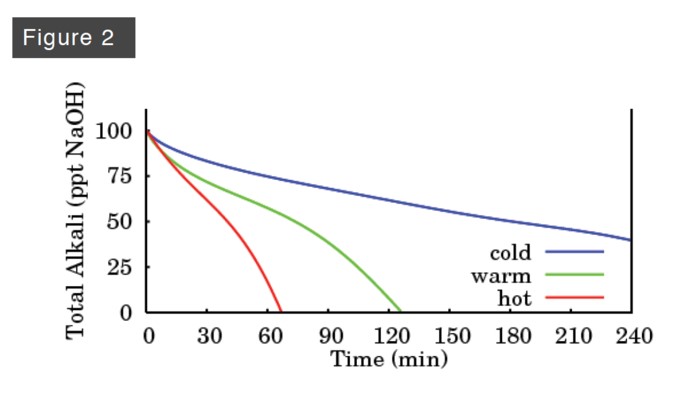| |
|
|
|
|
|
| Hot Stuff |
Author: Kevin Dunn
Friday, March 3, 2017 |
|
The cold process is not exactly cold. The oils are generally warmed to something higher than room temperature, and once the lye is added, the raw soap can become quite warm indeed. Of course, the term arises because, unlike the hot process, no additional heat is provided once the oils and lye are mixed. Despite the name, temperature plays a large role in cold-process soap, and we will explore that relationship in this article.
When oil and lye are first mixed, the consistency of the raw soap is quite fluid, but becomes gradually thicker as the first bit of oil turns to soap. When enough soap has formed, it emulsifies the remaining oil and the mixture becomes so thick that a spoon dragged across its surface leaves a trace, a mark of where it has been. At this stage, soaps of different colors may be mixed and crafted into complex artistic patterns. If the soap were thinner, the colors would simply blend, leaving little contrast between them. If it were any thicker, the soap would stiffen and clump like mashed potatoes, and the characteristically smooth texture of cold-process soap would be lost. Soap at trace is just right for crafting.
When I began pondering the mysteries of trace, I wondered whether increasing the temperature of the oils would hasten trace or retard it. Warming an oil generally decreases its viscosity, that is, it gets thinner and flows more easily. Honey and glycerin behave this way, as do almost all liquids. So on the one hand, I would expect an increase in temperature to delay the appearance of trace because the oils are thinner and less viscous at high temperature than at low temperature.
On the other hand, the whole reason that we have trace is because some of the oil has turned to soap. And chemical reactions almost universally happen more quickly at high temperatures than at low ones. Cooking is a familiar example of this. So we should expect an increase in temperature to hasten the appearance of trace because soap is being produced more rapidly at high temperature. Thus, we have two separate and opposite phenomena, one thinning the soap and the other thickening it as the temperature increases. Which one will win?
You can’t think your way to an answer to this question—you have to run an experiment. And to run an experiment you need to be able to measure both temperature and viscosity. Everyone is familiar with thermometers as a way to measure temperature, but measuring viscosity requires less familiar equipment. Fundamentally, viscosity is a resistance to flow, and there are many ways to measure it. We used a “shell cup viscometer,” a stainless steel funnel about the size of a shot glass. You dip the cup into the fluid to be measured and use a stopwatch to time how long it takes for the fluid to drain from the cup. The longer the time, the higher the viscosity. A calibration graph provided with the cup converts seconds into the unit of viscosity, the centiPoise (cent-i-pwahs), or cP. From our experiments, trace corresponds to a viscosity of about 500 cP.
Armed with the shell cup viscometer, we measured the viscosity of soap made from our standard four-oil blend: 39% olive oil, 28% coconut oil, 28% palm oil, and 5% castor oil using lye with a concentration of 33% and no lye discount. We ran the experiment at three temperatures: 40ºC (104ºF), 50ºC (122ºF), and 60ºC (140ºF), running the gamut from rather cool to rather warm temperatures. Figure 1 shows what happened to the soap viscosity over the first 20 minutes after mixing. The soap viscosity increased for all three soaps, but it rose most rapidly for the warmest soap and least rapidly for the coolest. The warmest soap reached trace (500 cP) only four minutes after mixing, so rapidly that only three viscosity measurements could be made. The middle soap reached trace after eleven minutes, and the coolest soap after twenty-two minutes. Clearly the increase in reaction rate with increasing temperature wins out over the decrease in oil viscosity. The lesson for cold process soapmakers is that you can control the time needed to reach trace by controlling the temperature. Use warmer oils to reach trace more rapidly and cooler oils to reach it more slowly.
Figure 1 does not imply that the saponification reaction is over in 20 minutes. Far from it. In a separate experiment we measured the amount of sodium hydroxide remaining in soap as a function of time. The same oil blend was used as in the previous experiment, and the soaps were maintained at constant temperatures of 50ºC (122ºF), 60ºC (140ºF), and 70ºC (158ºF), referred to subsequently as cold, warm, and hot. Under real-world conditions, the temperature of soap increases during the initial phase of the reaction, reaches a peak, and then gradually falls. The details depend on whether or not the soap goes through gel phase. For this experiment, we wanted to eliminate these variations, and so we held the temperatures constant.
Figure 2 shows the results. All three soaps started with the same amount of sodium hydroxide, and the amount of sodium hydroxide remaining decreased gradually over time. When the concentration reached zero, the reaction was complete. For the hot soap, saponification was complete after a little more than an hour, and for the warm soap it was finished after two hours. The cold soap remained alkaline far beyond the four hour mark. It is clear that saponification is far from complete when the soap reaches trace. By combining the two graphs we can get a rough idea of how far the reaction has gone. In the first experiment, the soap at 50ºC reached trace after 11 minutes. In the second experiment, the soap at 50ºC still contained about 90% of its sodium hydroxide. The soap held at 60ºC in the first experiment reached trace in four minutes, and in the second experiment the 60ºC soap still contained about 95% of its sodium hydroxide at four minutes. In both cases, most of the sodium hydroxide remains unreacted when trace is reached. For this reason, I advise soapmakers to mix all of their ingredients (oils, colors, and scents) before adding their lye. The soap remains so alkaline at trace that there is no benefit to adding sensitive ingredients at trace, a time when soapmakers are preoccupied with artistic crafting and getting the soap into the molds before it begins to harden.


 |
| Buy Supplies - Related Items |
|
Questions & Answers (0) |
 |
| Question + Answer. Here you can ask or answer questions All questions are queued and answered quickly during business hrs. You can also answer questions posted by other customers if you have valuable information. |
 |
0 Question(s) Shown Below |
No items listed at this time, please check back often as we are adding kits/items everyday.
|
|
|
|
|
|
|